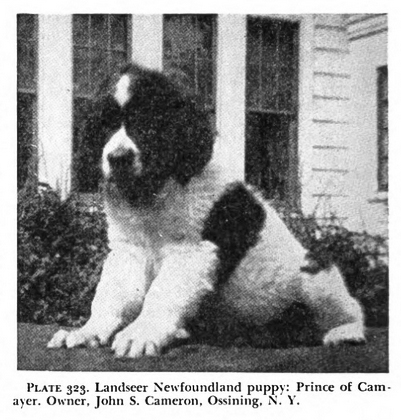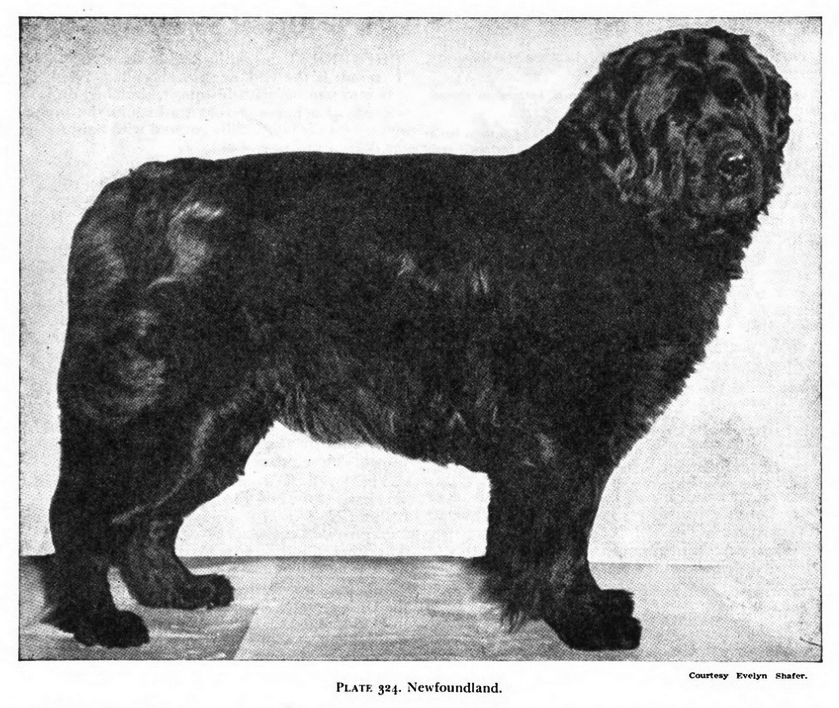A LONG AND romantic history has been built up around the Newfoundland dog, but in truth, most of it is pure conjecture. The most likely story is that the modern Newfoundland is the result of a cross between native Newfoundland dogs, or wolves, and ships' dogs; with the resultant strains purified and beautified in England.
Early writers do not mention any dog as being found on the island. This omission hardly seems possible if a dog of the size and striking individuality of the Newfoundland was in existence there.
Moreover, if today there are any dogs of this breed on the island, they are descendents of dogs bred in England. This is explained by saying that the demand for the dogs caused all of them to be exported to England and other European countries.
In his Discourse and Discovery of Newfound Land with the reason for a Plantation, Capt. Richard Whitbourne gives no indication that there were any kind of dogs on the island. But he does report that his "Mastiffe-dogge" mingled with the wolves on a number of occasions, and was gone nine or ten days on each.
The question immediately arises, could this Mastiff have mated with the wolves to produce the huge Newfoundland dogs? Whitbourne visited Newfoundland in 1615. Other ship's dogs may have mated with wolves, native dogs, or crosses between wolves and Whitbourne's Mastiff, to have produced the breed.
Whatever the truth of this conjecture, the earliest pictures of the Newfoundland show him to have possessed many of the characteristics of the Arctic dogs. The Arctic dogs themselves look suspiciously like wolves, and some of them, like the Arctic wolves, reach a weight well over 100 pounds.
As for these ship's dogs, it has been suggested that they were Abruzzi sheepdogs, or Great Pyrenees. But there actually is no real evidence to support such a claim.
Lieut. Col. Hamilton, an experienced dog investigator, visited Newfoundland about 1830. He reported that the true Newfoundland dog was black and tan. Also, the Newfoundland at that time did not equal the huge height of present-day dogs. A height of 26 to 27 inches seems to have been normal.
The greater size came in England. The reasons for this would appear to have been better care, a better climate, and the English genius for developing the type of dogs they desired in a very few generations.
Watson, the very hard-headed American authority, made a careful investigation of the Newfoundland. He is more circumspect in his chapter, but in his "Contents" he says: "A Modern English Development from a Mixed Lot of Common Dogs of Various Colours, Coats, and Sizes."
It is probable that we can accept this statement of Watson, and certainly without prejudice to a very noble animal. For the breed has spread over a large portion of the world strictly on the basis of his good looks and his undoubted merits.
At first, the British fancied an all-black dog. Then Sir Edwin Landseer painted a black and white New- foundland. This color became the rage in England. But until recent years, the blacks predominated in the United States, with the so-called Landseer type coming in later.
Watson points out that the Newfoundland was a superb water dog. As a result, all large water dogs were called Newfoundlands. He considered that Landseer was merely painting a large water dog, calling it a Newfoundland since, as he says, Landseer's dog is not distinguished by Newfoundland type.
Edward C. Ash quotes many articles and letters from British authorities to show the dog's superior ability in the water. These tell of the dogs being used to rescue objects — and humans — which fell into the water from ships or docks.
In 1929, life-saving trials for Newfoundlands actually were started in England by a Mr. Keeling at Studley Castle. Though successful they were not continued.
Few Newfoundlands were seen in the United States until after World War I. Watson mentions one, which he considered of exceptional quality. It was called Mayor of Bingley, and was brought to this country by a Mr. Mason in 1881. Two later imports which he considered first class were Captain and Black Boy.
The breed suffered in England during both World Wars. But it began a resurgence in America about 1935, and has continued to improve despite World War II. The dogs being shown today are of good type, excellent soundness, and unusually sweet dispositions. They still carry their inherent love of water. Both blacks and black and whites are being shown.
Among the fanciers chiefly responsible for the improvement and growth of the breed in recent years are: John S. Cameron of the Camayer Kennels, Ossinging, N. Y.; Waseeka Kennels, Ashland, Mass.; Grace E. Johnston, Buffalo, N. Y.; Denise O'Brien, Yonkers. N. Y.; Mrs. George B. Bacon, Cambridge, Mass.; Mrs. Elinor S. Sokol, Ossining, N. Y.; and Dr. Aristine P. Munn, Long Branch, N. J.
Among the better-known champions which have been produced in the last decade are: Nigor of Camayer, Barnacle Bill of Waseeka, Waseeka's Sea King, Denobie's Admiral Ben Bow, and Norka of Denobi.
Description and Standards. The description and standards, by courtesy of the Newfoundland Club of America, follow:
SYMMETRY AND GENERAL APPEARANCE. — The dog should impress the eye with strength and great activity. He should move freely on his legs, with the body swung loosely between them, so that a slight roll in gait should not be objectionable; but at the same time a weak or hollow back, slackness of the loins, or cow hocks should be a decided fault.
HEAD. — Should be broad and massive, flat on the skull, the occipital bone well developed; there should be no decided stop, and the muzzle should be short, clean cut, rather square in shape, and covered with short, fine hair.
COAT. — Should be flat and dense, of a coarsish texture and oily nature, and capable of resisting the water. If brushed the wrong way, it should fall back into its place naturally.
BODY. — Should be well ribbed up, with a broad back. A neck strong, well set on to the shoulders and back, and strong muscular loins.
FORELEGS. — Should be perfectly straight, well covered with muscle, elbows in but well let down, and feathered all down.
HINDQUARTERS AND LEGS. — Should be very strong; the legs should have great freedom of action, and a little feather. Slackness of loins and cow hocks are a great defect; dew claws are objectionable and should be removed.
CHEST. — Should be deep and fairly broad, and well covered with hair, but not to such an extent as to form a frill.
BONE. — Massive throughout, but not to give a heavy, inactive appearance.
FEET. — Should be large and well shaped. Splayed or turned-out feet are objectionable.
TAIL. — Should be of moderate length, reaching down a little below the hocks it should be of fair thickness and well covered with long hair, but not to form a flag. When the dog is standing still and not excited it should hang downwards, with a slight curve at the end; but when the dog is in motion, it should be carried a trifle up, and when he is excited, straight out, with a slight curve at the end. Tails with a kink in them or curled over the back are very objectionable.
EARS. — Should be small, set well back, square with the skull, lie close to the head, and covered with short hair, and no fringe.
EYES. — Should be small, of a dark-brown colour, rather deeply set, but not showing any haw, and they should be rather wide apart.
COLOUR. — Jet black. A slight tinge of bronze, or a splash of white on chest and toes is not objectionable.
HEIGHT AND WEIGHT. — Size and weight are very desirable so long as symmetry is maintained. A fair average height at the shoulders is 27 inches for a dog and 25 inches for a bitch, and a fair iaverage weight is respectively: dogs, 140 lb. to 150lb.; bitches, 110lb. to 120lb.
OTHER THAN BLACK. — Should in all respects follow the black except in colour, which may be almost any, so long as it disqualifies for the black class, but the colours most to be encouraged are black and white and bronze. Beauty in markings to be taken greatly into consideration.
Dogs that have been entered in black classes at shows held under kennel club rules where classes are provided for dogs other than black shall not be qualified to compete in other than black classes in future.
Black dogs that have only white toes and white breasts and white tip to tail are to be exhibited in the classes provided for black.
Scale of Points
Head
Shape of Skull....................................... 8
Ears....................................................... 10
Eyes...................................................... 8
Muzzle.................................................... 8
Points for head —— 34
Body
Neck....................................................... 4
Chest...................................................... 6
Shoulders............................................... 4
Loin and Back...................................... 12
Hindquarters and Tail........................... 10
Legs and Feet........................................ 10
Coat...................................................... 12
Size, Height, and General Appearance... 8
Body points —— 66
____
Total points 100
Markings of White and Black Dogs.
Head ......... 3
Saddle....... 5
Rump........ 2
Total — 10
"Definition for Preference"
Black head marked with narrow blaze.
Even marked saddle.
Black rump, extending on to tail.
The ten points above are to be considered in differentiating between "Landseers" not added to Standard.

